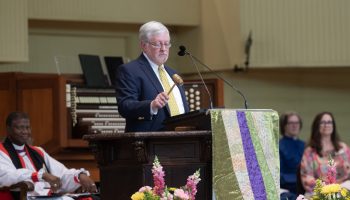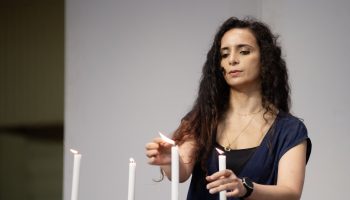
Susie Anderson
Staff Writer
Celebrated author George Saunders discussed storytelling as a cornerstone of humanity Thursday in the Amphitheater in a joint presentation for the Chautauqua Lecture Series and Chautauqua Literary and Scientific Circle during a week themed “Art in Action: Building Community through the Arts.”
A professor for the Master of Fine Arts Creative Writing program at Syracuse University, Saunders is an award-winning short story writer and recipient of the 2017 Man Booker prize for his debut novel Lincoln in the Bardo, which is being transformed into an operatic adaptation through commission from the Metropolitan Opera.
Saunders delved into literary arts as a writer and educator; his 2022 short story collection, Liberation Day, is the Week Three CLSC selection.
In his lecture, Saunders captured the power of storytelling to unlock empathy, the necessity of respect in a writer’s consideration of the reader, and the importance of supporting the arts. He began the talk with a confession.
“I’m a left-winger, unrepentant,” Saunders said. “I’m actually a little left of Gandhi. But I don’t want to give the talk from that perspective.”
Beyond partisan politics, Saunders said he detects a deep sadness and shared frustration that prevents people from presenting their best selves to one another.
“I have been working on the talk out of respect for Chautauqua for about two weeks, and I have zero answers. So expect that,” Saunders said. “… Art doesn’t have to solve problems; it just has to formulate them correctly.”
Saunders shared an excerpt from Leo Tolstoy’s Resurrection that concluded with the line:
“Men think there are circumstances when one may deal with human beings without love, but there are no such circumstances.”
Rather than deliver an imperative, Tolstoy states a fact, Saunders said. However, the type of love described by Tolstoy is rare.
“In my very limited experience of this — it happened like once in 1978 or something — it’s a super power that answers all questions when you’re in that mode,” Saunders said.
Saunders referred to feeling that sense of intense love when losing someone he loves. He turned to the words of his professor at Syracuse, poet Hayden Carruth, who said, “Now, I am almost entirely love.”
“But who can do it?” Saunders asked. “I’m the grouchiest person in real life, storming around the house in my sweatpants because my novel isn’t working. Tolstoy, at the end of his life, got in a huge brawl with his wife, and he forbid her from coming to his deathbed. So this ‘all love’ is a nice idea. But even all ‘like’ would be nice.”

The type of all-encompassing love Carruth feels is difficult to achieve, Saunders said. Anxiety, pressures of the current political climate and the reality of human biology keep this love out of reach.
“We come out of the womb, and suddenly the world starts sorting itself out into ‘me’ and ‘not me,’ what I like and don’t like, who I love, don’t love,” Saunders said.
When people enter the world, Saunders said individuals quickly fall into four delusions about their individual existence.
“We have this feeling that we’re, first of all, fixed,” he said. “We’re solid. We’re permanent. We’re central. And we’re separate.”
While centering oneself might be fulfilling in some instances, Saunders said, in others, the notion of the “self” becomes a burden.
“When you get the diagnosis,” Saunders said, “when you have made a terrible mistake that hurts somebody’s feelings, self is a terrible jacket that you’re forced to wear.”
Saunders described himself as an “amateur neurologist” who recently learned how the back of the brain processes concepts and delivers it to the front of the brain to revise the concepts with precision and accuracy until it creates our reality.
“For example, if somebody kidnapped you and blindfolded you and set you down in here — which may be the case for some of you — as soon as the blindfold comes off, back here in the brain: ‘Oh, public space. Amphitheater. Old guy droning on. Oh, God, I’m at a literary talk,’ ” Saunders said.
In this way, the brain creates stories every moment of every day.
“In every instant of life, a vague first draft essentially is being revised into a polished final draft, which is also inaccurate, but it’s better than the first one,” he said. “That’s how we survive.”
In addition to the everyday storytelling in the mind, storytelling builds empathy. Saunders quoted the words of poet Henry Wadsworth Longfellow: “If we could read the secret history of our enemies, we should find in each man’s life sorrow and suffering enough to disarm all hostility.”
Saunders sees the relationship between character and reader as a means of disarming hostility by letting the reader imaginatively inhabit another person.
“A character is just us on a different day in a parallel life,” he said. “By extrapolation, the person sitting next to you is every bit as real as you, but in a different life. So that’s kind of a pretty good form of anti-siloing. You go to the page, and you’re transformed.”
Saunders argued that perhaps an even more important connection is generated between writer to reader. Approaching feedback, Saunders offered an image of a reader with a meter ticking between “positive” and “negative” while reading a story.
The second that the reader gets bored, Saunders said, the story is over.

“All the things we talk about — theme, plot, character, politics — they don’t exist because our relationship has been severed,” Saunders said.
Inviting a reader into his work, Saunders said, the writer drives a motorcycle with the reader in the sidecar.
“If I’m doing my job, when I lean left, you come with me,” Saunders said. “When I lean right, you come with me. All the way to the end of the story. And then I take that baby off the cliff, and you have no choice. You haven’t departed from me yet, so over we go together.”
In this process, Saunders said authenticity and respect from author to reader is essential.
“We might think of this process — you and me together in my story — as a form of microcommunity building. You’re saying, ‘Do you respect me?’ I’m saying, ‘I do.’ Over and over. Every line of the thing,” he said.
The biggest obstacle in this trusting relationship, Saunders said, is the author’s anxiety and desire to overcontrol the narrative. He compared the desire to direct the story along a particular narrative, theme or outline to bringing index cards on a date.
“That would maybe eliminate your anxiety for a while,” he said. “But what (that) would indicate is non-involvement. It’s autopilot. And autopilot is the enemy of art. It’s also the enemy of any kind of communication, as we know.”
Overcoming this autopilot is no easy feat and often yields temporary success.
“To simply say, ‘I’m going to not condescend to anyone today.’ It works for five minutes. Someone cuts you off in traffic, and you immediately know what political party they belong to,” Saunders said.
In writing, correcting autopilot occurs through editing. Saunders let the audience into his editing process beginning with a simple sentence: “One day, Bob came into the living room and sat down on the brown couch.”
“That’s English,” Saunders said. “But something about it doesn’t feel right. And I think there’s condescension. So, I start cutting. Every day is ‘one day.’ And I leave ‘one day’ in there — in a tiny way, you feel less respect from me. I wasted your time by two words. So I cut those out.”
By the time Saunders cuts out all the condescending words in the sentence, he is left with one: “Bob.” However, Saunders said, one name makes for a better sentence — a truer sentence — than the one he started with.
“Better sentences send you in search of music, the sound, which weirdly sends you off in search of truth. … As you try to write a better sentence, a truer sentence,” he said, “that leads you down the holiest path of all — and this is going to be a big disappointment: Specificity. If you can be specific, the doors to the kingdom open up.”
Utilizing specificity, Saunders transformed the sentence “Bob was a bad person” to “Bob snapped impatiently at the young barista who reminded him of his dead wife, dear Maria, who he missed so much.”
In revising the sentence, Saunders added humanity. In a positive offramp, Saunders emphasized the importance of storytelling as a critical tool for humanity, particularly for children.
“Literature, as we know, is a suffering-reduction machine,” he said. “It’s the best gift you can give a kid because that kid will continue to move toward a belief that others are as real as she is. … She will be moved away from those four delusional ideas of permanence and centrality by the books she reads.”
However, Saunders acknowledged the unavoidable and pervading cruelty in everyday life in the world.
“In the true Chautauqua spirit, I want to go past the groovy exit into a zone of higher truthfulness, which will provide us with a nice buzzkill at the end,” he said. “But it will be a truthful buzzkill.”
The truth is not everyone reads fiction, Saunders said. Regularly addressing audiences in colleges and cities, Saunders has identified a commonality among the people hearing his words.
“They tend to be a left-leaning audience. The test for this is that Gandhi joke I made at the beginning. So the siloing is real. To simply say, ‘Everyone read more fiction,’ sadly, that’s not going to do the trick,” he said.
Covering a Donald Trump rally in 2016, Saunders told people he was a reporter for The New Yorker.
“Nobody had heard of it. One guy said, ‘Is that a liberal thing?’ And again, that’s their right. That’s on me, not on them,” he said. “But the idea that no matter how eloquent I’m in The New Yorker — how forceful — it’s siloed. That’s the sobering truth. I don’t have an answer for that except to say, ‘Yeah, that’s happening and it’s getting worse.’ ”
At age 66, having just finished a new book, Saunders said he has asked himself, what next?
Rather than capitulate to the feeling that the world has gone south, Saunders said he wants to spend his time following the words of Desmond Tutu: “Do your little bit of good where you are; it’s those little bits of good put together that overwhelm the world.”
One little way Saunders amounts bits of good is by putting pen to paper.
“Every day I sit down, and I start off not quite believing other people are as real as I am,” he said. “And I start telling a story, and suddenly, they are. Or at least one is in the story.”
Beyond generating humanity through his words, Saunders closed with a commitment to spend his time upholding and defending the ideals he holds dear.
“I’m going to try to renew my belief in the power of art,” he said. “Renew my vows to fiction by doing more of it and believing more single-pointedly in its power. I’m going to be sassy and self-assured and funny in the defense of art, freedom and kindness. I’m going to be sneaky, and I’m gonna be wry and be so wild that I can’t be denied in defense of people who are now in the path of this pervasive cruelty.”




